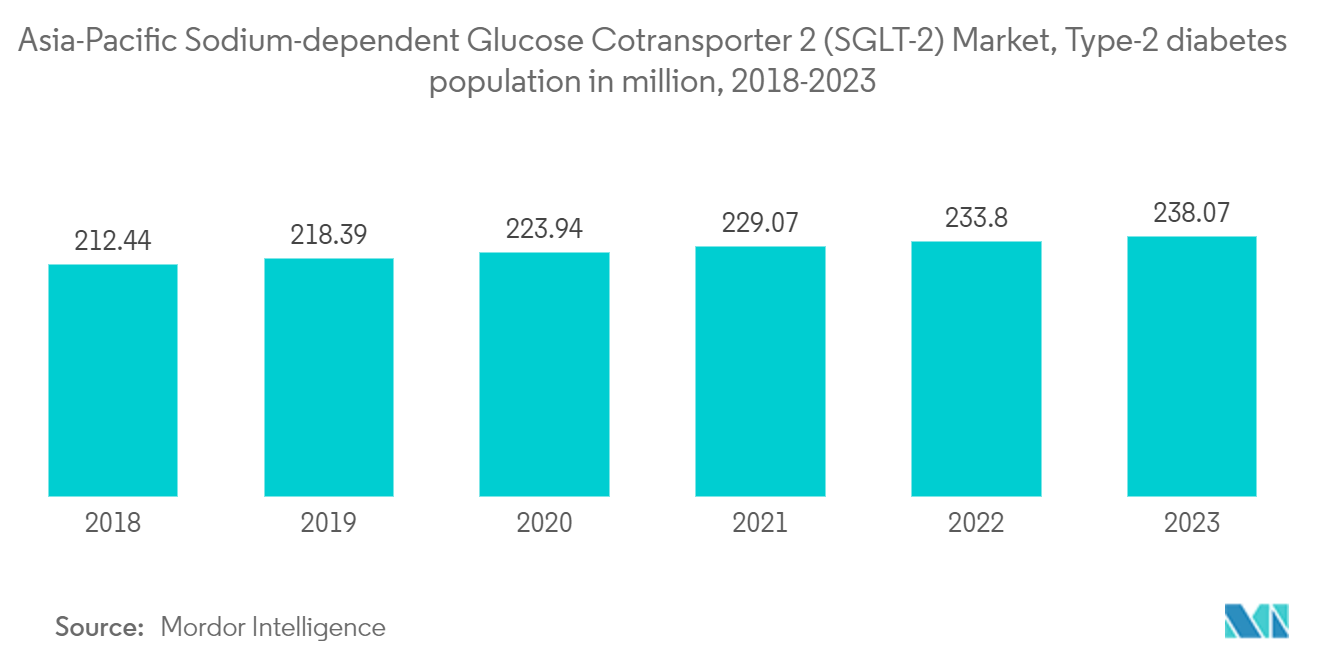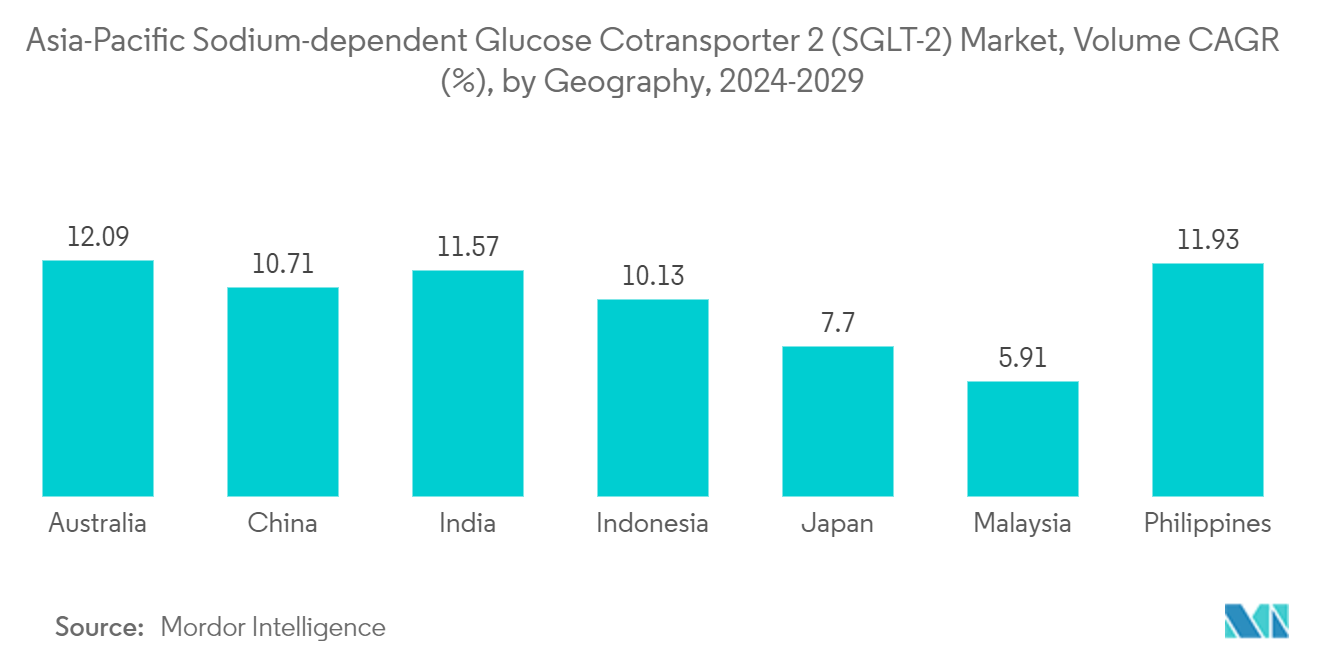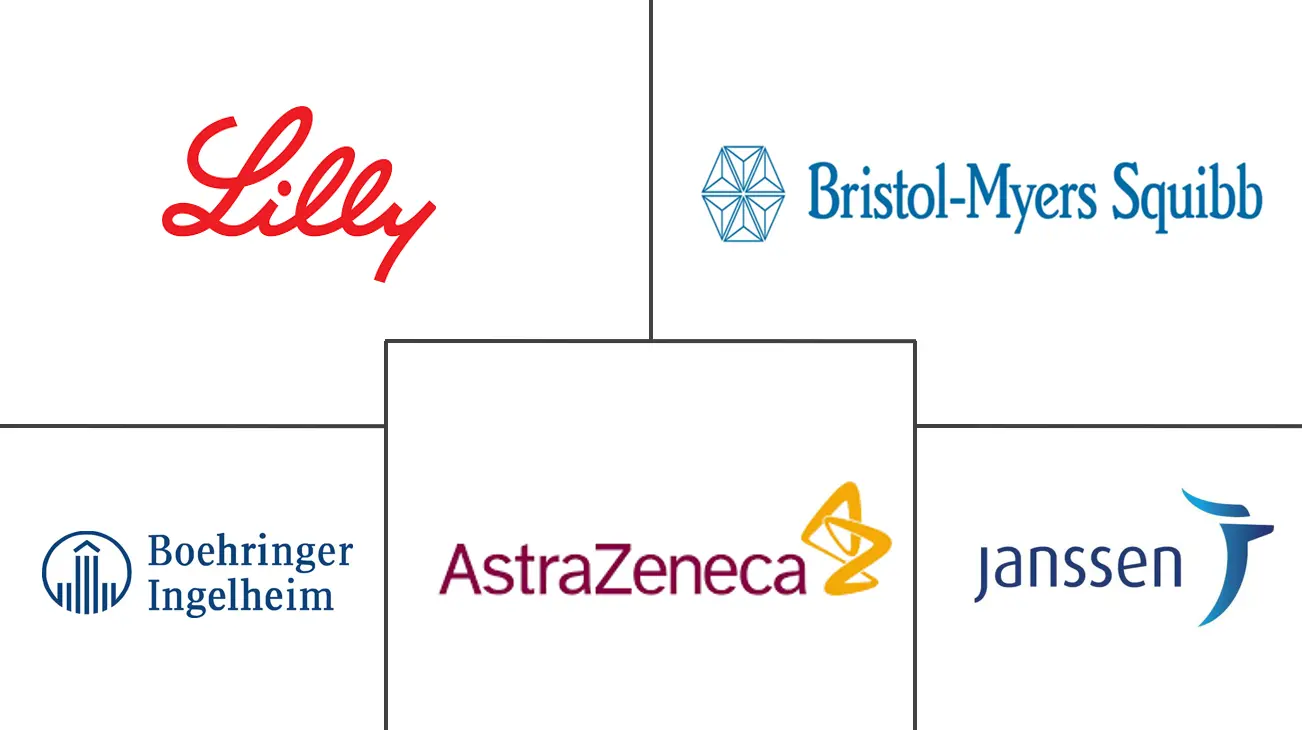
Asia-Pacific Sodium-dependent Glucose Cotransporter 2 (SGLT-2) Market Analysis
The Asia-Pacific Sodium-dependent Glucose Cotransporter 2 Market size is estimated at USD 1.97 billion in 2025, and is expected to reach USD 2.94 billion by 2030, at a CAGR of 8.35% during the forecast period (2025-2030).
SGLT-2 inhibitors also called gliflozins are a class of medicine used to lower high blood glucose levels in people with type 2 diabetes. SGLT-2 drugs have a significant role in managing cardiovascular risk factors including blood pressure, glycemia, weight, cardiac function, and antiinflammatory activity. Diabetic drugs have been potential candidates for treating diabetic patients affected by SARS-CoV-2 infection during the COVID-19 pandemic.
The Asia-pacific region had witnessed an alarming increase in the prevalence of diabetes, in recent years. Diabetes is associated with many health complications. Patients with diabetes require many corrections throughout the day for maintaining nominal blood glucose levels, such as medications or ingestion of additional carbohydrates by monitoring their blood glucose levels.
Diabetes mellitus has been of wide concern with its high prevalence, resulting in increased financial burdens for clinical systems, individuals, and governments. The market players are adopting various strategies such as collaborations, partnerships, mergers, acquisitions, and expansions to increase market share. Technological advancements have increased over the period leading to several modifications either in the SGLT-2 inhibitors or the formulations being developed.
According to International Diabetes Federation, 90 million adults were living with diabetes in the IDF South-East Asia Region. This figure is estimated to increase to 152 million by 2045, and 206 million adults were living with diabetes in the IDF Western Pacific Region, which is estimated to increase to 260 million by 2045. The Asia-Pacific region witnessed an alarming increase in the prevalence of diabetes in recent years. In developing countries, such as China and India, the rate of diabetes is at an all-time high. Also, the use of oral anti-diabetes drugs is rising because new-generation drugs reduce the rate of CV risk in diabetes patients. Leading manufacturers are focusing on technological innovations and developing advanced products to gain a substantial market share.
Therefore, due to increased prevalence and the aforementioned factors, the studied market is anticipated to witness growth over the analysis period.
Asia-Pacific Sodium-dependent Glucose Cotransporter 2 (SGLT-2) Market Trends
Jardiance Segment holds the highest market share in the Asia-Pacific Sodium-dependent Glucose Cotransporter 2 (SGLT-2) Market in the current year
Jardiance holds the highest market share of about 43.3% in the Asia-Pacific Sodium-dependent Glucose Cotransporter 2 (SGLT-2) Market in the current year.
Jardiance is a prescription medicine to lower blood sugar, diet, and exercise in adults with type 2 diabetes. It reduces the risk of cardiovascular death in adults with type 2 diabetes, including cardiovascular disease. Jardiance also reduces the risk of cardiovascular death and hospitalization for heart failure in adults when the heart cannot pump enough blood to the rest of the body. It is not for people with type 1 diabetes.
SGLT-2 inhibitor drugs are available internationally and are recommended for use when escalation of treatment for type 2 diabetes is required, along with lifestyle management. Oral agents are typically the first medications used in treating type 2 diabetes due to their wide range of efficacy, safety, and mechanisms of action. SGLT-2 inhibitor drugs help diabetes patients control their condition and lower the risk of diabetes complications. People with diabetes may need to take antidiabetic drugs for their whole lives to control their blood glucose levels and avoid hypoglycemia and hyperglycemia. These agents present the advantages of easier management and lower cost. So they became an attractive alternative to insulin with better acceptance, which enhances adherence to the treatment.

Japan is expected to dominate Asia-Pacific Sodium-dependent Glucose Cotransporter 2 (SGLT-2) Market over the forecast period
Japan holds the highest market share in the Asia-Pacific Sodium-dependent Glucose Cotransporter 2 (SGLT-2) Market in the current year and is expected to grow with a CAGR of about 8% over the forecast period.
Japan includes around 11 million people with diabetes, according to IDF data. While Type 1 diabetes is caused by an immune system malfunction, Type 2 diabetes is linked to leading a sedentary lifestyle, resulting in inherent resistance to insulin. Japan contains one of the largest elderly populations in the world, which is more susceptible to the onset of type 2 diabetes. As Japan's population continues to age, the prevalence of diabetes also increases. The rise in the number of people with type 2 is driven by a complex interplay of socio-economic, demographic, environmental, and genetic factors. Key contributors include urbanization, an aging population, decreasing levels of physical activity, and increased levels of overweight and obesity.
Much can be done to reduce the impact of diabetes. Evidence suggests that type 2 diabetes can often be prevented. In contrast, early diagnosis and access to appropriate care for all types of diabetes can avoid or delay complications in people with the condition. When diabetes is undetected or inadequately treated, people with diabetes are at risk of serious and life-threatening complications, such as heart attack, stroke, kidney failure, blindness, and lower-limb amputation. These result in reduced quality of life and higher healthcare costs.
Diabetes is identified as a healthcare priority by the Ministry of Health, Labour, and Welfare. The costs of diabetes are increased in patients with co-morbidities such as hypertension and hyperlipidemia and in patients who develop complications. Costs increase with an increasing number of complications. Well-organized medical insurance systems cover all medical fees for diabetes mellitus, and people with diabetes can visit doctors freely in Japan.
Therefore, owing to the factors above, the growth of the studied market is anticipated in the Asia-Pacific Region.

Asia-Pacific Sodium-dependent Glucose Cotransporter 2 (SGLT-2) Industry Overview
The Asia-Pacific Sodium-dependent Glucose Cotransporter 2 (SGLT-2) Market is highly consolidated, with major manufacturers, namely Eli Lilly, Sanofi, and Novo Nordisk, with a global and regional market presence. The joint ventures that occurred between players in the recent past helped the companies strengthen their market presence. For example, Eli Lilly and Boehringer Ingelheim make Jardiance together, which is a very popular SGLT-2 class drug.
Asia-Pacific Sodium-dependent Glucose Cotransporter 2 (SGLT-2) Market Leaders
-
Eli Lilly
-
Boehringer Ingelheim
-
Janssen Pharmaceuticals
-
AstraZeneca
-
Bristol Myers Squibb
- *Disclaimer: Major Players sorted in no particular order

Asia-Pacific Sodium-dependent Glucose Cotransporter 2 (SGLT-2) Market News
- June 2023: the U.S. Food and Drug Administration approved Jardiance (empagliflozin) and Synjardy (empagliflozin and metformin hydrochloride) as additions to diet and exercise to improve blood sugar control in children 10 years and older with type 2 diabetes. These approvals provide a new class of medicines taken by mouth to treat pediatric type 2 diabetes.
- November 2022: AstraZeneca announced new findings from a pre-specified DELIVER Phase III trial data analysis. It shows that Farxiga (dapagliflozin) improved symptom burden and health-related quality of life in patients with heart failure and mildly reduced or preserved ejection fraction compared with a placebo.
Asia-Pacific Sodium-dependent Glucose Cotransporter 2 (SGLT-2) Industry Segmentation
SGLT-2 inhibitors are an oral medication for treating type 2 diabetes in adults. They are prescription drugs called sodium-glucose co-transporter-2 inhibitors (SLGT2i) or gliflozins. The Asia-Pacific Sodium-dependent Glucose Cotransporter 2 (SGLT-2) Market is segmented into drugs and geography. The report offers the value (in USD) and volume (in units) for the above segments.
| Geography | Japan |
| South Korea | |
| China | |
| India | |
| Australia | |
| Vietnam | |
| Malaysia | |
| Indonesia | |
| Philippines | |
| Thailand | |
| Rest of Asia-Pacific |
Asia-Pacific Sodium-dependent Glucose Cotransporter 2 (SGLT-2) Market Research FAQs
How big is the Asia-Pacific Sodium-dependent Glucose Cotransporter 2 Market?
The Asia-Pacific Sodium-dependent Glucose Cotransporter 2 Market size is expected to reach USD 1.97 billion in 2025 and grow at a CAGR of 8.35% to reach USD 2.94 billion by 2030.
What is the current Asia-Pacific Sodium-dependent Glucose Cotransporter 2 Market size?
In 2025, the Asia-Pacific Sodium-dependent Glucose Cotransporter 2 Market size is expected to reach USD 1.97 billion.
Who are the key players in Asia-Pacific Sodium-dependent Glucose Cotransporter 2 Market?
Eli Lilly, Boehringer Ingelheim, Janssen Pharmaceuticals, AstraZeneca and Bristol Myers Squibb are the major companies operating in the Asia-Pacific Sodium-dependent Glucose Cotransporter 2 Market.
What years does this Asia-Pacific Sodium-dependent Glucose Cotransporter 2 Market cover, and what was the market size in 2024?
In 2024, the Asia-Pacific Sodium-dependent Glucose Cotransporter 2 Market size was estimated at USD 1.81 billion. The report covers the Asia-Pacific Sodium-dependent Glucose Cotransporter 2 Market historical market size for years: 2019, 2020, 2021, 2022, 2023 and 2024. The report also forecasts the Asia-Pacific Sodium-dependent Glucose Cotransporter 2 Market size for years: 2025, 2026, 2027, 2028, 2029 and 2030.
Our Best Selling Reports
APAC SGLT2 Inhibitors Industry Report
Statistics for the 2025 Asia-Pacific Sodium-dependent Glucose Cotransporter 2 (SGLT-2) market share, size and revenue growth rate, created by Mordor Intelligence™ Industry Reports. Asia-Pacific Sodium-dependent Glucose Cotransporter 2 (SGLT-2) analysis includes a market forecast outlook for 2025 to 2030 and historical overview. Get a sample of this industry analysis as a free report PDF download.



